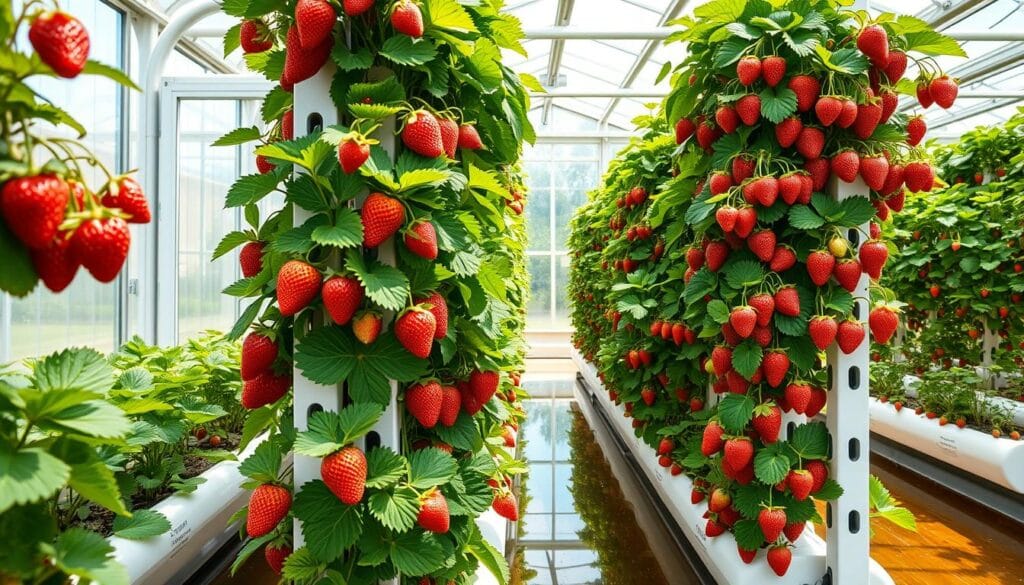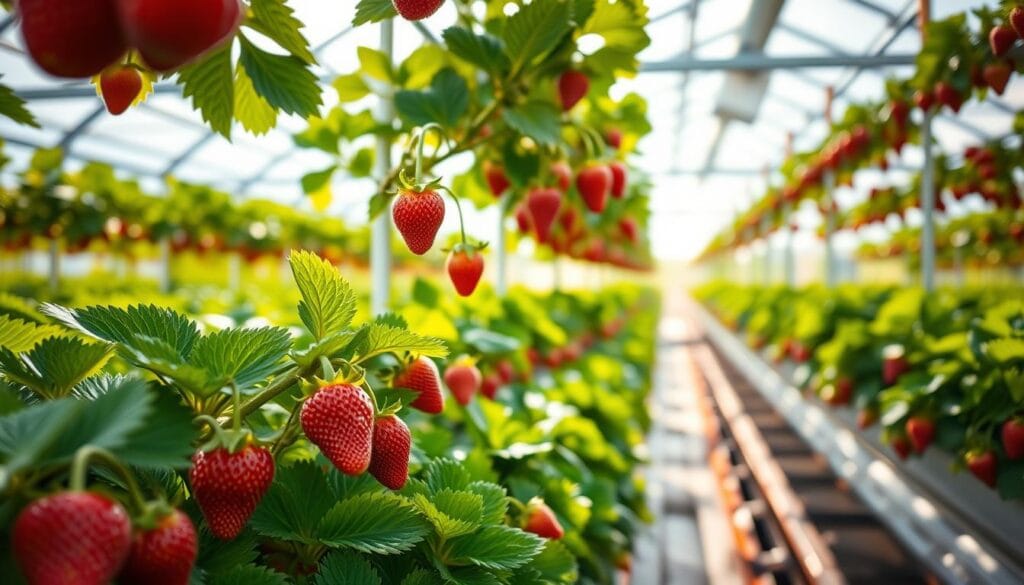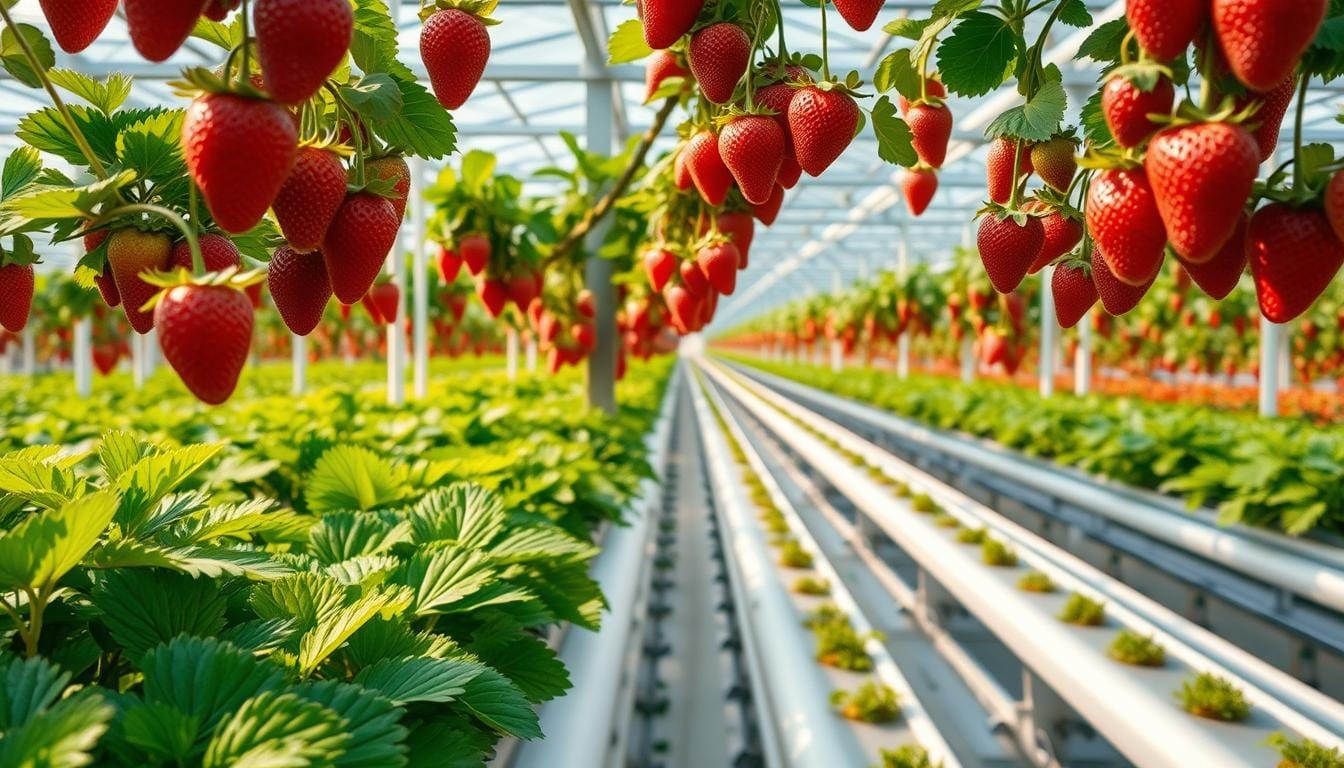Growing up in California’s agricultural heartland, I never imagined strawberries could thrive without soil. My first encounter with hydroponic strawberry farming was like discovering a secret garden suspended in technology. The vibrant red fruits growing in water-based systems seemed almost magical, challenging everything I knew about traditional farming.
Hydroponic strawberry farming represents a revolutionary approach to cultivation. By eliminating soil and creating controlled environments, you can grow delicious strawberries year-round, regardless of external weather conditions. This innovative soilless cultivation method transforms indoor strawberry growing from a distant dream into an achievable reality.
Whether you’re an urban gardener with limited space or an agricultural enthusiast seeking sustainable growing techniques, hydroponic strawberry farming offers incredible opportunities. Understanding the right strategies can help you maximize yields, reduce water consumption, and enjoy fresh, pesticide-free strawberries whenever you want.
Key Takeaways
- Hydroponic systems can cut water consumption by as much as 90%
- Year-round strawberry production is possible indoors
- Precise nutrient control leads to higher crop yields
- Space-efficient method ideal for urban environments
- Minimizes risks of soil-borne diseases
- Allows for continuous harvesting of strawberries
Understanding Hydroponic Strawberry Farming
Hydroponic strawberry farming is a new way to grow berries. It uses a soilless method that boosts crop quality. This method changes how we grow plants by avoiding soil problems.
What Makes Hydroponics Different from Traditional Growing
Hydroponics is a fresh take on growing strawberries. It’s different because it doesn’t use soil. Instead, it controls what plants eat and how they grow.
- Elimination of soil-related disease risks
- Direct nutrient delivery to plant roots
- Enhanced growth control and monitoring
- Reduced water consumption
Benefits of Soilless Cultivation
Hydroponic strawberry farming has big benefits. It lets plants grow faster and stronger. It also helps plants fight off pests better.
- Faster growth cycles
- Higher crop yields
- Improved pest resistance
- Year-round production capabilities
“Hydroponics transforms strawberry cultivation by providing unprecedented precision in plant management.” – Agricultural Innovation Research Team.
Environmental Impact and Sustainability
Hydroponic strawberry farming is good for the planet. It consumes far less water than conventional agricultural practices. This makes it a green choice.
| Metric | Hydroponic Advantage |
|---|---|
| Water Usage | 90% Reduction |
| Pesticide Requirements | Minimal |
| Space Efficiency | Vertical Growing Possible |
Starting up with hydroponics costs more. But, the long-term gains make it a smart choice for farmers looking to the future.
Essential Equipment and Setup Requirements
Starting a strawberry hydroponics setup needs careful planning and the right tools. You’ll learn about the key parts that turn your growing area into a strawberry paradise.
- LED grow lights for optimal plant development
- Water circulation pumps
- Nutrient reservoirs
- Precision pH and EC meters
- Ventilation systems
“Success in hydroponic strawberry farming starts with investing in quality equipment and understanding your system’s unique requirements.”
When picking your hydroponic gear, think about these important points:
| System Type | Beginner Suitability | Space Requirements |
|---|---|---|
| Nutrient Film Technique (NFT) | High | Compact |
| Deep Water Culture (DWC) | High | Moderate |
| Drip System | Medium | Flexible |
Pro tip: Spend on quality hydroponic gear from the start for lasting success and better strawberry harvests. Even though it costs more at first, a well-made system pays off big time.
Keeping your hydroponic strawberry setup in top shape is key. Watch the environment, keep your tools clean, and be ready to tweak things as you get better.
Choosing the Right Hydroponic System Type
Choosing the right hydroponic system is key for growing strawberries. It depends on your space, experience, and goals. Each system has its benefits for growing strawberries well.
Knowing about different hydroponic systems helps you choose wisely. Let’s look at the top methods for growing strawberries:
Nutrient Film Technique (NFT)
NFT systems are great for small spaces. They use a thin film of nutrients that flows over the roots. This provides plants with the essential nutrients and oxygen required for their growth.
- Ideal for small-scale and beginner hydroponic setups
- Minimal growing medium required
- Excellent root oxygenation
- Low water and nutrient consumption
Deep Water Culture (DWC)
DWC systems have plants floating in nutrient-rich water. It’s simple and affordable for gardeners.
| DWC System Characteristics | Benefits |
|---|---|
| Plant Suspension Method | Roots directly in nutrient solution |
| Oxygenation | A continuous air pump provides oxygen |
| Maintenance | Low complexity, easy monitoring |
Drip Systems and Aeroponics
Drip systems deliver nutrients right to the roots, great for commercial growers. Aeroponics is the most advanced, with roots in the air and misted with nutrients.
“Choosing the ideal hydroponic system has the potential to revolutionize strawberry cultivation, enhancing both yield and quality
Think about the cost, complexity, and your growing space when picking a system. Each has its perks for growing tasty, high-yield strawberries.
Selecting Optimal Strawberry Varieties

Selecting the appropriate strawberry varieties for hydroponic cultivation is crucial for achieving success. With over 10,000 varieties, picking the best for your system is vital. It greatly affects your crop’s outcome.
Day-neutral strawberries are the top pick for hydroponics. They produce fruit all season long. This makes them perfect for indoor growing.
“The choice of strawberry varieties accounts for 50% of successful production” – Hydroponic Farming Experts
When picking hydroponic strawberry varieties, consider a few things:
- Flavor profile
- Disease resistance
- How well they grow in controlled spaces
- If they work well with hydroponics
Here are some top day-neutral varieties for hydroponics:
- Albion – Known for consistent yields
- Seascape – Excellent flavor and adaptability
- Eversweet – Produces sweet, uniform fruits
Look into European varieties like ELSANTA and CLERY for hydroponics. ELSANTA has sweet, firm flesh. CLERY does well in cooler weather.
Your success in growing hydroponic strawberries depends on matching varieties to your growing space and goals.
Nutrient Management and pH Balance
Good hydroponic nutrient management is key for healthy strawberries. Your strawberry plants need balanced nutrition and pH for the best growth and harvests.
Essential Nutrients for Strawberry Growth
Hydroponic strawberries need a special mix of nutrients to grow well. The main nutrients your plants require are:
- Nitrogen (N): Important for leaf and growth
- Potassium (K): Helps with fruit growth and plant strength
- Calcium (Ca): Stops blossom end rot and strengthen cells
- Magnesium (Mg): Needed for chlorophyll
Maintaining Proper pH Balance for Strawberries
Maintaining the correct pH level is essential to ensure effective nutrient uptake. Your hydroponic strawberry system needs a pH between 5.5 and 6.5 for best nutrient use.
“A balanced pH is the secret to unlocking maximum nutrients in hydroponic strawberry cultivation.”
Addressing Nutrient Deficiencies
Quickly finding and fixing nutrient deficiencies keeps your strawberry plants healthy. Look out for these common signs:
| Nutrient | Deficiency Symptoms | Correction Strategy |
|---|---|---|
| Calcium | Leaf tip burn, weak stems | Adjust nutrient solution, add calcium supplements |
| Iron | Yellowing between leaf veins | Use chelated iron supplements |
| Magnesium | Yellowing older leaves | Apply Epsom salt solution |
Pro tip: Change your nutrient solution every 7-14 days to keep nutrients balanced and prevent salt buildup.
Environmental Control and Climate Optimization
Creating the best growing conditions is key for hydroponic strawberry farming. You need to control many environmental factors to help plants grow well and produce more. This includes keeping the temperature, humidity, light, and airflow just right.
“Success in hydroponic strawberry cultivation relies heavily on precision and meticulous attention to detail.
Your strawberry environment needs careful watching. Look at these important factors:
- Temperature regulation between 60-80°F
- Controlled humidity levels
- Strategic lighting management
- Consistent air circulation
Understanding the balance of these elements is vital. Strawberry plants do best in specific conditions. These conditions help them grow strong and produce lots of fruit.
| Environmental Parameter | Ideal Range | Impact on Growth |
|---|---|---|
| Temperature | 60-80°F | Promotes healthy plant development |
| Humidity | 50-70% | Prevents fungal diseases |
| Light Intensity | 29.9 µmol m-2s-1 | Supports photosynthesis |
| CO2 Levels | 597-600 ppm | Enhances growth efficiency |
Using advanced tech like Priva Climate Computer can help manage these factors. It ensures your strawberries grow in the best conditions all year round.
With smart climate control, you can make a perfect environment. This environment supports strawberry growth all year long.
Disease Prevention and Pest Management
Keeping your strawberry crops healthy in a hydroponic system is key. Hydroponics helps lower disease risks, but you must stay alert. This ensures your plants stay healthy.
Common Hydroponic Plant Diseases
Strawberry plants in hydroponics face several challenges. The main issues include:
- Powdery mildew (thrives in humidity over 60%)
- Botrytis (gray mold)
- Root rot
- Nutrient deficiency diseases
Integrated Pest Management Strategies
Preventing diseases in strawberries needs a detailed plan. Your strategy should include early detection and specific actions.
| Pest | Size | Control Method |
|---|---|---|
| Aphids | 1/8 inch | Biological controls, neem oil |
| Thrips | 1 millimeter | Sticky traps, predatory insects |
| Spider Mites | Various colors | Increased humidity, predatory mites |
Preventive Maintenance Practices
Follow these steps to protect your hydroponic strawberries:
- Keep temperatures above 68°F
- Humidity should be 50-70%
- Ensure good ventilation
- Regularly sterilize equipment
- Check the nutrient solution pH (5.5-6.5)
Proactive management is the key to preventing diseases in your hydroponic strawberry system.
Prevention is better than treatment in hydroponic pest management. Keep your environment clean, watch your plants closely, and act fast when problems come up. This way, your strawberry crops will stay healthy and productive.
Harvesting and Post-Harvest Handling

Learning how to harvest hydroponic strawberries is key to keeping them fresh and increasing your yield. Understanding the right timing and method for harvesting is crucial.
Timing is everything when harvesting strawberries. Look for these signs:
- Deep, vibrant red color across the entire fruit
- A firm texture with a gentle yield under light pressure
- Harvesting crops early in the morning enhances their sugar levels, ensuring maximum sweetness
After picking, it’s important to care for your strawberries well. Gentle handling is key to avoiding bruising and keeping the fruit intact. Here are important steps for post-harvest care:
- Cool strawberries immediately to 32-36°F (0-2°C)
- Maintain high humidity levels between 90-95%
- Store in shallow containers to prevent crushing
- Minimize handling to reduce damage
“The key to turning good strawberries into exceptional ones lies in the meticulous attention given to harvesting and handling.
The durability and freshness of your strawberries are strongly influenced by the quality of your post-harvest care methods. By following these steps, you can keep your hydroponic strawberries fresh longer. This ensures they are of the highest quality for eating or selling.
Maximizing Yield and Production Efficiency
Successful hydroponic strawberry production needs smart strategies for better yield and efficiency. You must use special techniques that work well with soilless growing. This ensures you maximize the potential of your harvest.
- Plant Density Optimization
- Space plants 8-12 inches apart
- Use vertical growing systems to make the most of space
- Choose compact varieties
- Growth Cycle Management
- Plant at different times for a steady supply
- Pick fast-growing types like Albion and Seascape
- Keep the environment stable
Strategic Production Scheduling
Good planning is key for efficient strawberry production. Your schedule should include:
- Enough light (8-16 hours a day)
- Right temperature (65-75°F)
- Accurate nutrient care
“Success in hydroponic strawberry farming is about creating the perfect environment for consistent, high-quality fruit production.”
Record Keeping and Continuous Improvement
Keep detailed records of your work. Note down planting dates, types, yields, and conditions. Ongoing learning and adaptability are crucial for enhancing your skills in hydroponic strawberry farming.
By using these methods, you can greatly improve your hydroponic yield and strawberry production. This will turn your farming into a precise, data-driven process.
Conclusion
Starting your journey in hydroponic strawberry production is a big step towards sustainable farming. It uses advanced methods to grow strawberries better than traditional farming. Hydroponics lets you control plant growth, leading to higher yields and less waste.
Water efficiency is key in hydroponic strawberry farming. These systems use up to 90% less water than old farming methods. This makes them great for the planet. Growing strawberries all year in controlled spaces also boosts your profits, making your farm more stable.
New tech keeps pushing sustainable farming forward. Hydroponics leads the way with better nutrient control and fewer pesticides. By following this guide, you can build a strong strawberry farm that’s good for both your pocket and the planet.
Learning and being open to change are vital in hydroponic farming. As new methods and tech come along, staying up-to-date is key. By embracing hydroponics, you can change how you farm strawberries for the better.

